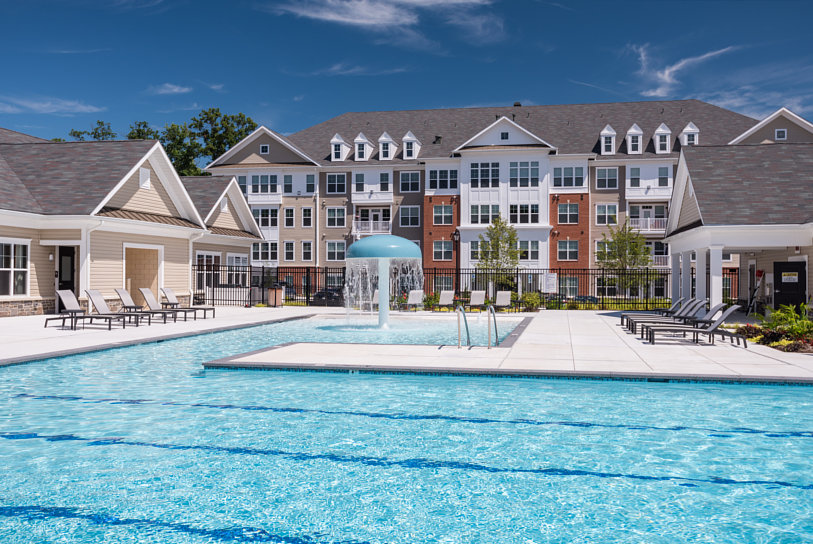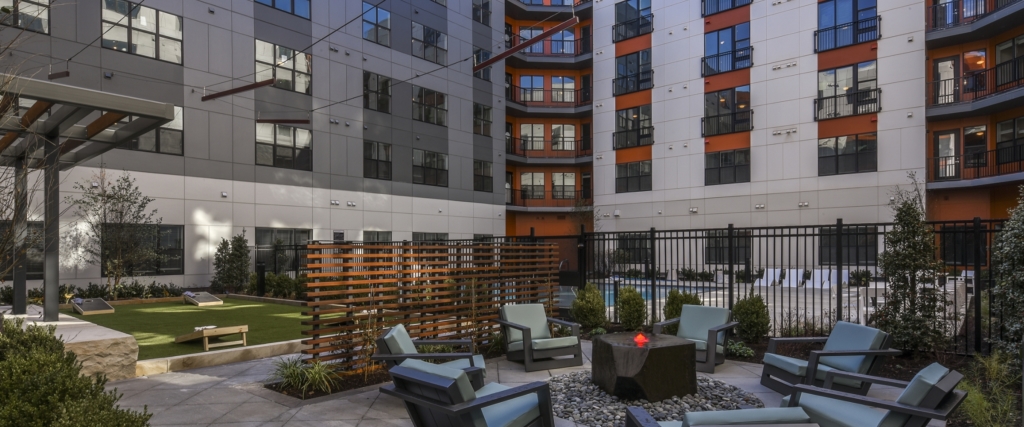Multifamily market attracts robust investment
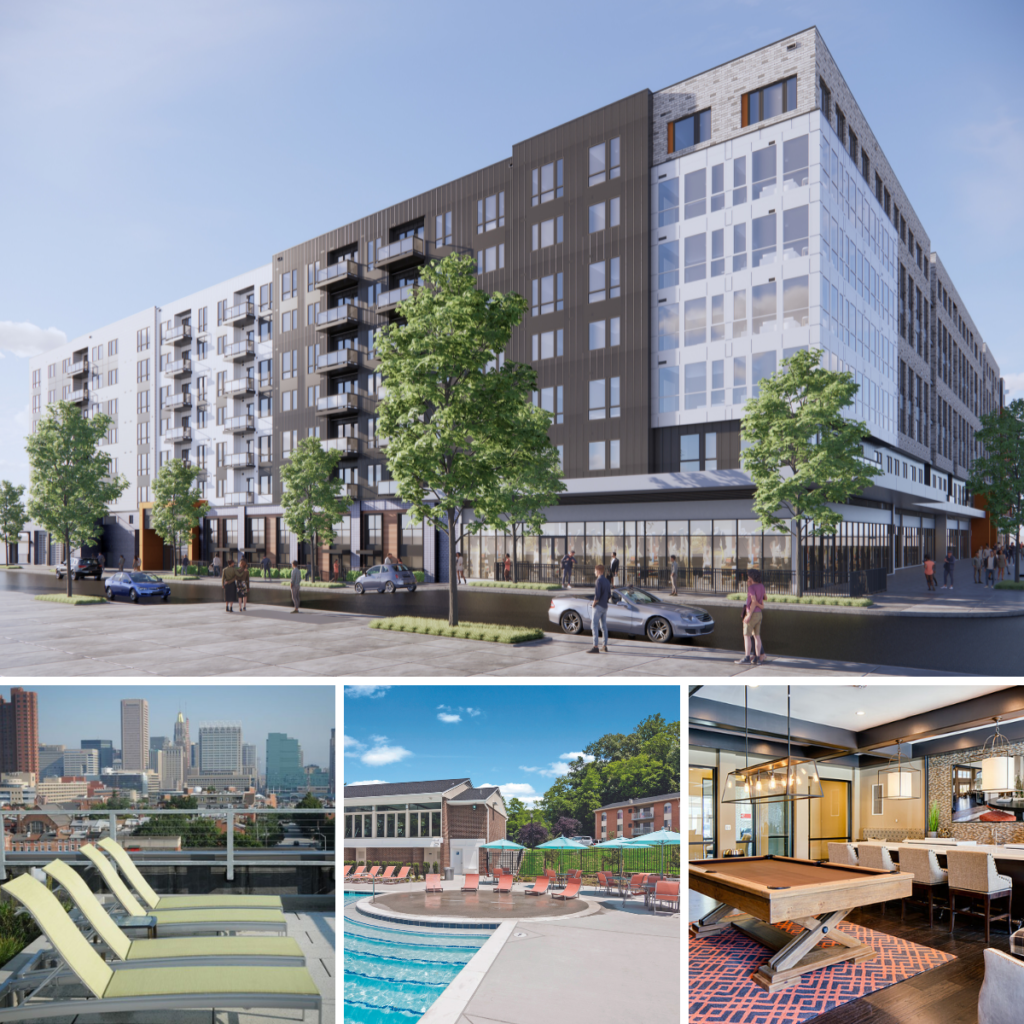
Strong investor interest and consumer demand is producing a rich variety of multifamily spaces in Maryland, from the Marlow in Columbia to a rooftop terrace at 1111 Light Street, a pool at Padonia Village and a pool room at the Enclave at Box Hill. Photos courtesy of Howard Hughes Corporation, Caves Valley Partners, Continental Realty Corporation and Bavar Properties Group.
The rooftop terraces offer panoramic views of Baltimore City as residents sip drinks from the lounge, tend to something tasty on a grill or simply sunbathe. Elsewhere in the buildings, people gather at resort-style pools, state-of-the-art fitness centers, resident taverns, lounges with enormous fireplaces and TVs, coworking spaces, game lawns, courtyards, doggie parks and pet spas. Others unwind in apartments that boast oversized windows, luxury finishes and the conveniences of living in a full-service building.
A decade ago, this was not a common depiction of residential life in South Baltimore. Yet a spate of multifamily developments – Anthem House, Stadium Square, Alta and others – brought a new product type and new vibrancy to the region.
Today, the multifamily market in Baltimore City and Central Maryland is extraordinarily strong. Enthusiastic investors, developers and property managers are looking to expand the offerings of high-quality residences in multiple locations. It’s a trend that could improve the quality of life of some communities, complement the office sector and create new opportunities for retail.
Enthusiastic investors
“When I moved back to Baltimore in 2000, I was shocked that there was nothing in Baltimore like the apartments I had seen in Atlanta. There was no highly amenitized multifamily in downtown Baltimore,” said Arsh Mirmiran, a Partner in Caves Valley Partners.
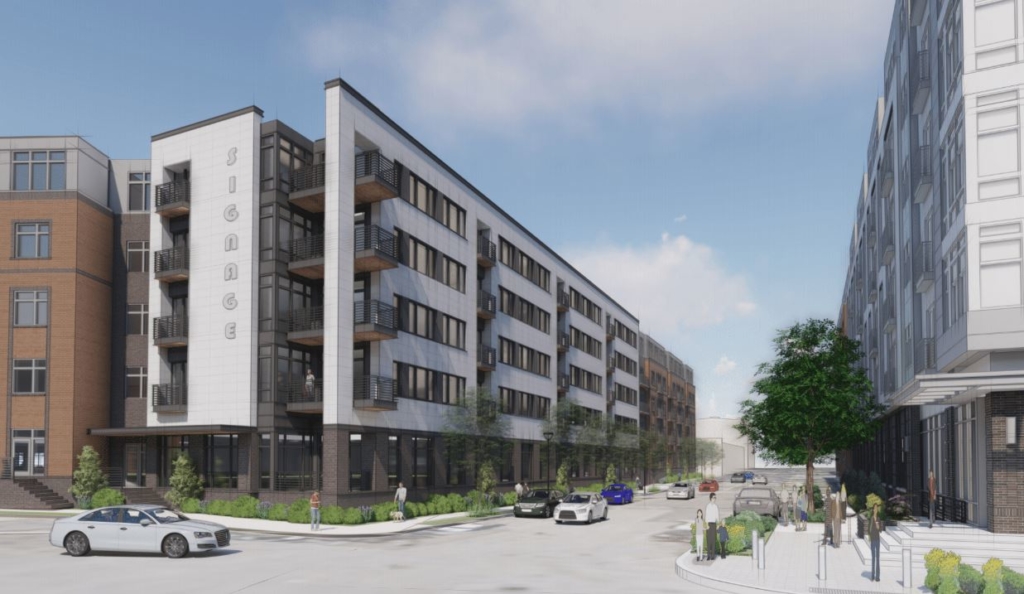
In South Baltimore, Caves Valley Partners helped transform former industrial properties into a dense, mixed-use neighborhood that includes a cluster of gleaming multi-family developments. Image courtesy of Caves Valley Partners.
Years later, Caves Valley executed some “fairly complicated site assemblies” in South Baltimore and Federal Hill to facilitate the development of five, large, luxury multifamily projects – 1111 Light Street, two residential buildings at Stadium Square and another two on South Hanover Street.
The two Hanover Street projects “are essentially the final pieces in creating this fairly dense, multifamily-driven neighborhood in South Baltimore where, 10 years ago when Chesapeake Realty Partners did their building in the area [1901 South Charles Street], it felt like they were pioneering,” Mirmiran said. “It has been remarkable to see the transformation and improvement of that neighborhood as former industrial land was repurposed as a mixed-use development with apartment buildings and office buildings.”
The investor appetite for multifamily developments in Central Maryland has grown further in recent years.
“The desire to own this asset class is stronger than ever,” said Ari Abramson, Vice President, Acquisitions at Continental Realty Corporation. “We are seeing investors flood back into the multifamily market, urban and suburban alike. We are at record levels of sales transactions and the majority of those took place in urban areas, such as downtown Baltimore.”
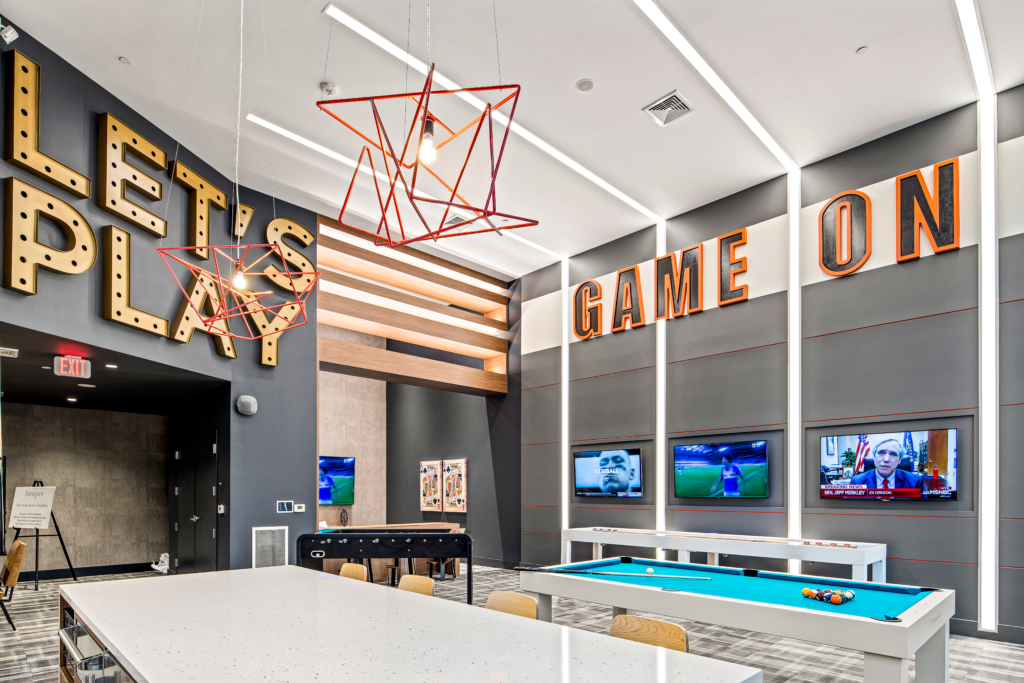
Developers are tailoring their multifamily designs to meet tenants’ desire for amenities. Juniper includes a games room, music room and makerspace. Photo courtesy of Howard Hughes Corporation.
Investors, Abramson said, are attracted to the region because of its durable economy. “It is anchored in life science, education and technology so it is seen as a safe economy with a solid employment base.”
Ongoing development at Port Covington and Harbor East are expected to draw more young professionals to the region and further strengthen the demand for multifamily properties, he said. In addition, recent, high-quality, high-density multifamily developments in “first ring markets” – including Towson, Owings Mills and Columbia – have demonstrated high demand for apartments and condominiums in “urbanesque settings” that have ample retail and quality schools.
Vibrant communities
The importance of the community surrounding a multifamily development can’t be understated, according to Greg Fitchitt, President, Columbia at the Howard Hughes Corporation. “You can build the most beautiful building but if you build it on an island and don’t pay attention to what’s around it, it’s not going to be nearly as successful.”
Through a series of developments in recent years, Howard Hughes Corporation has been bringing a new kind of multifamily product to the Columbia market, namely high-density, urban-style apartments in a mixed-use environment. The projects – which include the Metropolitan, TENm.flats, Juniper and the soon-to-be-completed Marlow – have been very successful, attracting mostly young professionals and some empty nesters.
Ongoing research has shown that tenants “want to live a walkable lifestyle where they have a lot of restaurants to choose from, a lot of things to do outside of their apartments and connection to nature which is one of our strong points in downtown Columbia with the lake, open space throughout the Merriweather District and connection to the 100 miles of pathways that go all through Columbia,” Fitchitt said.
Those community amenities remain important even in lower-density locations. Bavar Properties Group has deliberately chosen to do its multifamily developments – The Enclave at Box Hill, The Enclave at Emmerson and the upcoming Overlook at Shipley Homestead – within mixed-use, highly amenitized locations.
“We focus on mixed-use environments because we believe people want walkable or drivable retail. They want to be within easy reach of a Wegman’s, restaurants, fitness centers. They want green space and a community with amenities,” said Robert Bavar, Vice President. “In those settings, the multifamily market has been strong and will continue to be a focus for us in the short and long-term.”
Tenant preferences
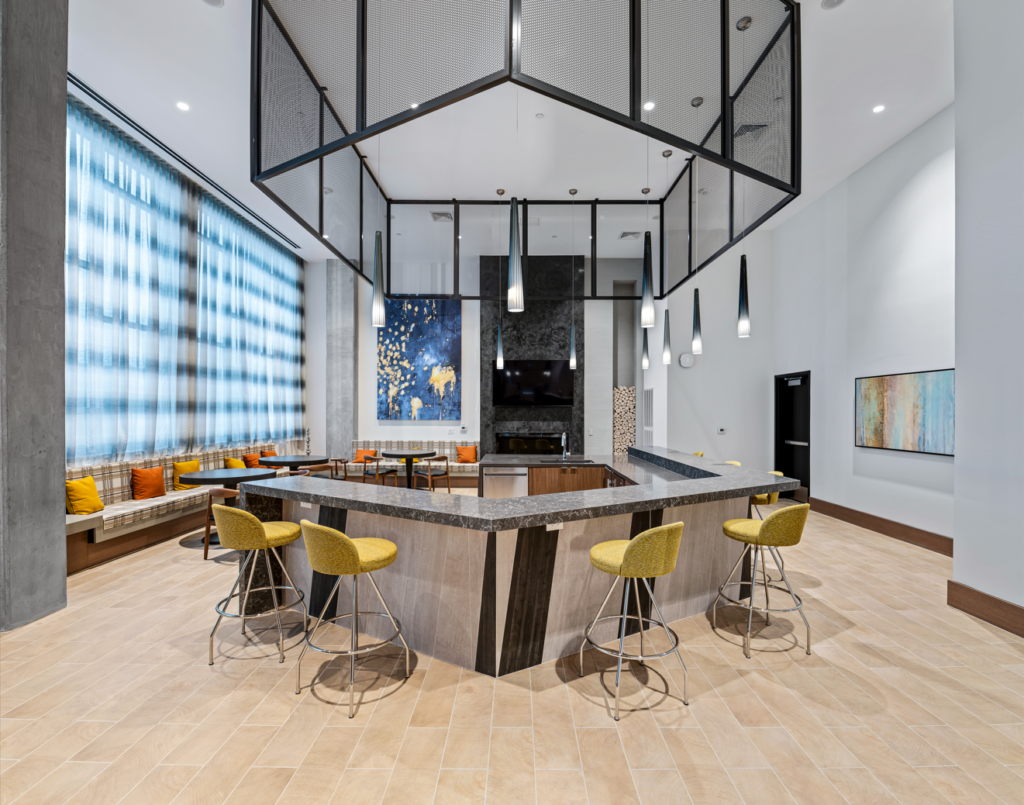
Today’s apartment dweller often wants multiple, attractive spaces to relax outside of their units, such as tenant lounges and interior courtyards. Photo courtesy of Howard Hughes Corporation.
Successful projects, however, also hinge on clearly understanding the demographics of renters or buyers and their current desires.
Each successive project in Columbia taught Howard Hughes Corporation more about its would-be tenants.
“One thing we learned is that Columbia is a really strong one-bedroom and studio market,” Fitchitt said.
Its tenant mix is overwhelmingly singles, couples and some couples with a very young child. Unlike many urban centers, Columbia is not a roommate market. Consequently, Howard Hughes adjusted its unit mix in subsequent projects to include fewer two- and three-bedroom apartments. In addition to the desire for a vibrant community, those tenants also want ample in-building amenities, such as a fitness center, pool, lounge space and coworking space. They also value amenities tailored to the property.
“At Juniper, we have a music room that has a grand piano that we got from Merriweather so it was played by many of the artists who performed there,” Fitchitt said. In keeping with the cultural emphasis of the Merriweather District, Juniper also includes a makerspace and original Gail Holliday artworks depicting Columbia’s neighborhoods.
Through a series of developments around Mount Vernon, Federal Hill, Harbor East, Fells Point and downtown Baltimore, Chasen Companies has finetuned its understanding of what potential tenants want.
“People are looking for a more modern finish than what is prevalent in Baltimore,” said Laura Malagari, Chief Administrative Officer. Chasen’s tenants, who are typically young professionals aged 25 to 35, “are looking for kitchen islands, hardwood floors, in-unit washers and dryers. They want to see plenty of recessed lighting because an apartment that doesn’t have recessed lighting means you have to go buy a bunch of lamps. Outdoor space is a huge thing whether it is a private deck or outdoor space with the building. Definitely, smart home technology and other bonuses, like the Alexas we offer in units, is attractive.”
Chasen, which has purchased and renovated multiple heritage buildings to create Class A apartments, has found strong demand for its boutique-style buildings with 10 to 50 units, said Drew Peace, Chief Business Development Officer. The company, which is currently developing a 100-unit building in the former Sheppard Electric Building on Aliceanna Street and a 172-unit development at the former Meyers Seed Building on Caroline Street, has posted strong lease rates for both the apartments and ground-floor commercial space in its larger buildings.
“Our last property, 520 S. Caroline Street, was 92 percent preleased before we delivered the building on January 1st and that includes two commercial units,” Peace said.
That ground-floor commercial space in Chasen’s redeveloped buildings “creates newer, brighter space with floor-to-ceiling windows, energy-efficient systems and a modern feel within a space that has also preserved heritage elements of the building,” Peace said. “It’s very attractive to commercial tenants” and sized to appeal to the current, smaller space needs of many retail and office tenants.
